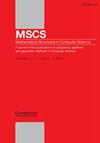Parameterized complexity of weighted team definability
IF 0.9
4区 计算机科学
Q4 COMPUTER SCIENCE, THEORY & METHODS
引用次数: 0
Abstract
In this article, we study the complexity of weighted team definability for logics with team semantics. This problem is a natural analog of one of the most studied problems in parameterized complexity, the notion of weighted Fagin-definability, which is formulated in terms of satisfaction of first-order formulas with free relation variables. We focus on the parameterized complexity of weighted team definability for a fixed formula加权团队可定义性的参数化复杂性
本文研究了具有团队语义的逻辑的加权团队可定义性的复杂性。这个问题是参数化复杂性中研究得最多的问题之一--加权法金可定义性概念--的自然类比,它是用具有自由关系变量的一阶公式的满足度来表述的。我们重点研究基于中心团队逻辑的固定公式 $\varphi$ 的加权团队可定义性的参数化复杂度。给定一阶结构 $\mathcal{A}$ 和参数值 $k\in \mathbb N$ 作为输入,问题是确定 $\mathcal{A},T 是否为某个大小为 k 的团队 T 的 \varphi$ 模型。此外,我们还将加权团队可定义性的复杂性与众所周知的 W-层次结构中的复杂性类别以及 paraNP 联系起来。
本文章由计算机程序翻译,如有差异,请以英文原文为准。
求助全文
约1分钟内获得全文
求助全文
来源期刊

Mathematical Structures in Computer Science
工程技术-计算机:理论方法
CiteScore
1.50
自引率
0.00%
发文量
30
审稿时长
12 months
期刊介绍:
Mathematical Structures in Computer Science is a journal of theoretical computer science which focuses on the application of ideas from the structural side of mathematics and mathematical logic to computer science. The journal aims to bridge the gap between theoretical contributions and software design, publishing original papers of a high standard and broad surveys with original perspectives in all areas of computing, provided that ideas or results from logic, algebra, geometry, category theory or other areas of logic and mathematics form a basis for the work. The journal welcomes applications to computing based on the use of specific mathematical structures (e.g. topological and order-theoretic structures) as well as on proof-theoretic notions or results.
 求助内容:
求助内容: 应助结果提醒方式:
应助结果提醒方式:


